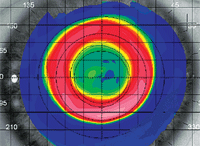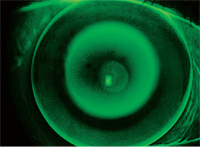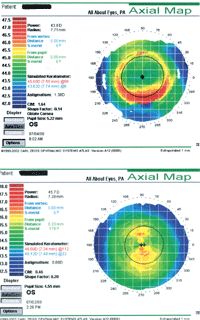Orthokeratology (ortho-k) is the use of rigid gas-permeable contact lenses, normally worn only at night, to improve vision through the reshaping of the cornea. This method can be used as an alternative to eyeglasses, refractive surgery or for those who prefer not to wear contact lenses during the day. Patients who want good visual acuity without the use of daytime contact lenses or glasses and those who do not desire surgery or are not candidates for refractive surgery benefit greatly from ortho-k. Some patients cannot tolerate daytime contact lens wear because of dryness or allergies, while others have a career or hobby that doesn’t allow for the use of glasses or contact lenses. Because insurance does not cover ortho-k, patients must be motivated to proceed as self-pay. In children, ortho-k could control myopia, which is also a motivating factor for many parents.

Perfect topography in an ortho-k patient after months of
treatment.
Utilizing orthokeratology can be financially beneficial for your practice as it requires private pay, which means no hassles with insurance or vision plan coverage. It is one of the most rewarding additions you can make to your practice, and if candidates are selected appropriately, your patients will become ambassadors for your practice, helping you set yourself apart from those who merely perform eye exams.
All low to moderate myopes should be considered candidates for ortho-k until proven otherwise. Engage patients in conversation and take note of your patients’ careers and hobbies; a thorough history will give you an opportunity to present ortho-k as an option. Many adults crave visual freedom from traditional forms of vision correction but do not want to take the step toward refractive surgery.
Treating children with orthokeratology is especially rewarding. When the long-term benefits are discussed with patients, they can usually see the treatment as an investment in their child’s vision similar to orthodontic braces they would get for their teeth. There are no age limitations for ortho-k, and we have achieved success in our practice with children as young as seven years old.
Study findings show that ortho-k slows myopic progression in children. In fact, several different studies have demonstrated this effect. But, keep in mind: Using ortho-k for myopia control is considered off-label.1 Still, telling parents about the latest research presents a great opportunity to educate and inform them of this possibility for their child. In my experience, this discussion is often a major factor in parents’ decision to go forward with their child’s orthokeratology treatment.
For all these reasons, ortho-k is always one of the options I present to select patients who come to me with hopes of achieving better vision. The key with this option is proper patient selection, as it will help you deliver on the promises you make. In addition to the professional and personal satisfaction that comes with offering orthokeratology, it has become a profit center in my practice. Let’s take a look at how you can implement this in your practice.
What is Required for Ortho-k?

This is the desired sodium fluorescein pattern in an ortho-k candidate.
Most of the things required to fit ortho-k lenses are already in an optometrist’s office: slit lamp, phoropter and topographer. Patients must receive a good refraction and an evaluation of their corneal health that includes topography. The topographer is a must-have for success with ortho-k. Once you begin to fit these patients on a regular basis, it will pay for itself quickly.
Preliminary testing is important with ortho-k because treatment should not be initiated if corneal integrity is compromised. For example, if a patient is suffering from moderate to severe dry eye, I recommend that the cause of the dry eye also be addressed and treated. This shows patients that optometrists are capable of handling their medical eye care issues, as well as refractive ones. Depending on the severity, ortho-k can sometimes be initiated simultaneously with dry eye treatment, but often the doctor may decide to wait until the condition is stable.
Educate Yourself and Your Staff
Once you have the diagnostic tools you need, your next step is to receive proper training for you and your staff. Your staff members must understand the process from start to finish, as well in preparation for questions from prospective and current patients. Once you bring ortho-k into your practice, they will be reinforcing your message and advising patients about their treatment program.
Many lens companies offer online training and certification courses as well as webinars. Paragon CRT design even offers certification through their website,
www.paragoncrt.com.2
The site also features webinars to help train doctors and staff. It offers tips on marketing CRT as well as how to fit these lenses successfully. Bausch + Lomb also offers online training through its Vision Shaping Treatment VST Method certification courses and examinations.3 Whatever method of training you choose, it is recommended that both staff and doctors complete the course.
For more specific education courses, the Orthokeratology Academy of America (
http://okglobal.org) has an annual meeting with speakers from all across the world. This meeting is by far one of the most informative meetings on ortho-k in the U.S.
Training, such as an ortho-k boot camp is available for new fitters—as well as more advanced training for those wanting to learn about new developments and treatments outside the regular FDA parameters. Joining their organization allows one to become a member of their Google group, which can be very helpful in addressing day-to-day challenges of ortho-k patients.
Once you and your staff begin training, it is best to stay with one primary lens choice and become familiarize yourself with fitting that lens. The doctor should also become familiar and comfortable with the problem solving systems of the chosen lens design. There have been several years of studies in the fitting of each design, so following the manufacturers’ recommendations when making changes to the lenses is always best. The consultants at each lab are a valuable resource, as they work with the doctor to assist in the learning process as well.
Determine Fees
You will have to be comfortable developing prices for your chair time. Most doctors develop a global fee that covers fitting, follow-ups, lens exchanges, etc. for a defined time period.
Make sure your fees are high enough to cover anticipated costs and time.4 The expertise of fitting these lenses has a value. Developing a contract with prices spelled out and a clear refund policy will also eliminate headaches. If you choose to offer financing options, there are companies you can employ that can help you set that up.
We use CareCredit Healthcare Finance, and they even have interest-free options for patients. The application process is simple and can be completed in the office by phone or online.
We require full payment before treatment is initiated, but some offices have worked out payment plans.
Which Lens Should You Use?
In deciding which lens to use, there are options that involve using fitting sets versus empirical fitting and ordering the trials one by one. Fitting from a trial set provides an instant reward for the patient and also allows the doctor to make changes on site by selecting a different lens based on what is seen. Patients appreciate taking their lenses home and getting started right away. It is not as big of an initial investment to order trial by trial, but having a set should be a goal once the investment can be made. This may end up being a time saver for the doctor and the patient.
For fitting set promotions, lens manufacturers are a good start. For instance, the patent-pending CRT SureFit Delivery System from Paragon Vision Sciences provides certified practitioners a single-use, three-lens per eye fitting and dispensing system to help ensure a high probability of day-one, first fit success with Paragon CRT.5 This can be a good option for an individual without a fitting set or a patient that has parameters outside the regular fitting set. It is also important to compare policies of the lab you select. Many of the ortho-k designs are not returnable like regular gas permeable lenses. Keeping the lenses that did not work can help the doctor slowly build a set. However, if a warranted lens makes the doctor more comfortable, check the lab’s policies.
Patient Selection and
Education
Who is a good candidate for ortho-k? Low to moderate myopes with little to no astigmatism will do best. It is recommended to start slow and only try more challenging cases after several successful fittings have been achieved in the lower ranges. Easy cases would be children under -3.00D and adults under -2.00D. A highly demanding patient may not be the best initial candidate during the learning process. A patient selected for ortho-k must have realistic goals. Remember that ortho-k is not for everyone, but it could work wonders for appropriate candidates.
Start out with a spherical myope. Don’t be afraid to ask experienced colleagues for consultation or advice, and consider observing their practice. An excellent first patient to boost your confidence can be a staff member, friend or a family member. Consider offering a significant discount to these new fits if they are friends, staff or loyal patients. Establish a goal for how many fits to accomplish during the first 60 days. With a significant discount, it should not be hard to fit 10 patients within 60 days. This will allow staff and doctors to gain confidence and witness the satisfaction of patients who have been fit. This enthusiasm can be contagious.

This eight-year-old male patient presented with a prescription of -2.75 D.S.(top), but after only one night of ortho-k, his visual acuity was 20/25 without correction (bottom). It was 20/20 after one week, with a residual refraction of plano D.S. Prior to treatment, the patients prescription doubled every year, but in his four years of treatment, he has not had any prescription shift. He and his parents are happy with his visual freedom in the daytime and his myopic stabilization.
Once confidence has been achieved, search your daily patient base for new candidates. Consider occupations. Patients who mention that they have difficulty with glasses or contact lenses because of their occupation, a firefighter for example, are candidates for ortho-k because it provides good vision without any devices. Even patients unable to wear regular contact lenses because of dry eye or allergy problems can succeed with ortho-k. When recording history, take note of hobbies such as sports, and especially, swimming. These patients appreciate the ability to see well without having to worry about ophthalmic devices.
Once the patients are fit, it is very important to educate them on how to care for and handle their new lenses. It’s crucial that patients continue to use the recommended lens care system and not stray. Opti-Free GP (Alcon) is a good choice. Another care system that has worked well for our ortho-k patients is Sauflon One-Step system (Sauflon). It’s a peroxide based system that is only available through a doctor’s office which ensures that patients are using the prescribed solution.6 Boston Simplus (Bausch + Lomb) is another one-step system that is available for ortho-k lenses. But, whichever system you choose, make sure your patients are instructed on how to use it properly. Another method of disinfection that is offered at many offices is in-office cleaning with Menicon Progent. A clean lens is most effective, which is why we include Progent in our contract as a covered service.7 It also gets the patient back into your office on a regular basis because we recommend a cleaning at least every three to six months. Annual replacement of lenses is also recommended. All of these points should be discussed during patient training. It’s wise to provide written instructions because the patient will not remember everything they hear during training.
Insertion and removal training should be performed by the staff before the patient leaves the office. It is important that the patient demonstrates success at insertion and removal and has confidence in the process. Many manufacturers recommend the use of plungers for removal of these lenses to avoid lens warpage. But, make sure your patients know how to remove lenses with and without a plunger in case the plunger is lost.
Doctor Dedication and Patient Pledge
At the day one follow-up, the patient will return to the office with the lenses on the eyes. At this time, take the initial visual acuity as well as an over-refraction and evaluate the lenses on the eyes. You are mainly looking for centration at this visit. After evaluating the lenses, they are removed and topography is performed. The cornea is examined for staining. If the patient had a significant starting prescription, we often issue daily contacts after this visit in decreasing steps for the patient to use during the daytime until the full effect of the molding has been achieved. You can expect approximately 1.50D-2.00D of treatment for most of the lenses in the first night.
Instruct patients to bring their lenses with them at all other follow ups. Visual acuities without lenses are taken and a residual refraction is performed. The cornea should be examined for any staining.
The patient must understand the importance of attending all required follow-up visits. There is generally a one-day, one-week, one-month follow up schedule. After that, it is decided case by case how often the patient needs to be seen, but if all is finalized, a six-month cornea and refraction check is considered the norm. These visits are described in the contract, which encourages the patient to comply. Purchasing a spare pair once parameters have been finalized is also recommended, so patients won’t have to wait if they break or lose a lens.
The price of the spare pair should be in the contract as well.
The importance of a written ortho-k contract cannot be underestimated. Because this process is an investment for patients, the contract should list expectations, instructions and an “out clause” if treatment is discontinued within the first two months by either the patient or the doctor. The contract should also include an emergency number in case patients must reach the doctor after hours. Remember, there are no guarantees with ortho-k and this should be documented as well. If a doctor chooses to fit outside of FDA guidelines, the patient needs to be aware of that as well. Every page should be initialed by the patient and carefully discussed with them to allow for clarification if there are any questions. A substantial amount of the fee should be non-refundable to cover the fitting process and the lenses, and that amount should be stated in the contract as well. If everything is spelled out, sticker shock at the front counter is avoided.
Spread the Word
Once you are comfortable with the process of fitting ortho-k lenses from start to finish and all systems are in place, promotion is the next step. Updating the practice website and sending out a message about new treatment offered in a newsletter format is a great way to allow current patients to know about the opportunity. If recall letters are routinely sent out, consider mentioning ortho-k in each of them. Submitting an article to the local paper is a great way to deliver this information to the general public. Depending on the size of the local market, a television spot may even interest the local television station.
Establish internal promotion in the office in the waiting area and in each exam room. Take advantage of manufacture brochures and display them at designated areas throughout the office. If your office has computers in each room, consider displaying messages about ortho-k on the screensaver. Most importantly, inform every patient who is a candidate about ortho-k as an option. But, your best promotion will stem from word of mouth once successful fittings are achieved.
Expanding the range of treatment options you offer to your myopic patients to include ortho-k creates many satisfied patients as well as an impressive amount of extra revenue for your practice. Orthokeratology is a win-win for everyone!
Dr. Allison is the owner of a private practice in San Antonio. She earned her Fellowship and is an active member of the Orthokeratology Academy of America. She lectures and she serves as a consultant for 2MEye, LLC practice consultants (
www.2MEyeConsulting.com).
1.Walline J. Slowing myopia progression with lenses. Cont Lens Spect. 2007 Jun;22(6):22-7.
2. ParagonCRT. Why ParagonCRT is the Right Choice for Your Practice. 2003-2004. Available at:
www.paragoncrt.com/ecp/index.asp. (Accessed December 2010).
3. Bausch + Lomb. Orthokeratology. 2010. Available at:
www.bausch.com/en_US/ecp/visioncare/product/general/ortho.aspx. (Accessed December 2010).
4. Rinehart JM, Reeves J. A Bright Idea. Available at:
www.optometric.com/article.aspx?article=70508. (Accessed December 2010).
5. Paragon Announces One-Day CRT Dispensing Without A Lens Inventory. Available at:
www.artoptical.com/news/paragon-announces-one-day-crt-dispensing-without-a-lens-inventory. (Accessed December 2010).
6. Daniels K. New Solutions for New Contact Lens Materials. Optometric Management. Available at:
www.optometric.com/article.aspx?article=&loc=articles\2006\march\0306094.htm. Accessed December 2010).
7. Menicon Progent. 2007. Available at:
www.nospecs.com.au/menicon-progent.php?nav=6. (Accessed December 2010).

